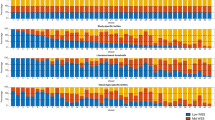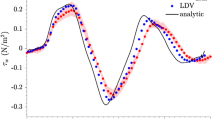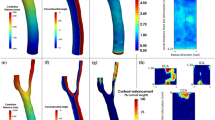Abstract
Large spatial shear stress gradients have anecdotally been associated with early atherosclerotic lesion susceptibility in vivo and have been proposed as promoters of endothelial cell dysfunction in vitro. Here, experiments are presented in which several measures of the fluid dynamic shear stress, including its gradient, at the walls of in vivo porcine iliac arteries, are correlated against the transendothelial macromolecular permeability of the vessels. The fluid dynamic measurements are based on postmortem vascular casts, and permeability is measured from Evans blue dye (EBD) uptake. Time-averaged wall shear stress (WSS), as well as a new parameter termed maximum gradient stress (MGS) that describes the spatial shear stress gradient due to flow acceleration at a given point, are mapped for each artery and compared on a point-by-point basis to the corresponding EBD patterns. While there was no apparent relation between MGS and EBD uptake, a composite parameter, WSS–0.11 MGS0.044, was highly correlated with permeability. Notwithstanding the small exponents, the parameter varied widely within the region of interest. The results suggest that sites exposed to low wall shear stresses are more likely to exhibit elevated permeability, and that this increase is exacerbated in the presence of large spatial shear stress gradients.
Similar content being viewed by others
References
Barbee, K. A. Role of subcellular shear-stress distributions in endothelial cell mechanotransduction. Ann. Biomed. Eng. 30: 472–482, 2002.
Barbee, K. A., T. Mundel, R. Lal, and P. F. Davies. Subcellular distribution of shear stress at the surface of flow-aligned and nonaligned endothelial monolayers. Am. J. Physiol. 268:H1765–H1772, 1995.
Buchanan, J. R., Jr., C. Kleinstreuer, G. A. Truskey, and M. Lei. Relation between non-uniform hemodynamics and sites of altered permeability and lesion growth at the rabbit aorto-celiac junction. Atherosclerosis 143:27–40, 1999.
Buchanan, J. R., C. Kleinstreuer, S. Hyun, and G. A. Truskey. Hemodynamics simulation and identification of susceptible sites of atherosclerotic lesion formation in a model abdominal aorta. J. Biomech. 36:1185–1196, 2003.
Butler, P. J., G. Norwich, S. Weinbaum, and S. Chien. Shear stress induces a time- and position-dependent increase in endothelial cell membrane fluidity. Am. J. Physiol. Cell Physiol. 280:C962–C969, 2001.
Caro, C. G., J. M. Fitz-Gerald, and R. C. Schroter. Atheroma and arterial wall shear. Observation, correlation and proposal of a shear dependent mass transfer mechanism for atherogenesis. Proc. R. Soc. Lond. B. Biol. Sci. 177:109–159, 1971.
Conklin, B. S., D. S. Zhong, W. Zhao, P. H. Lin, and C. Chen. Shear stress regulates occludin and VEGF expression in porcine arterial endothelial cells. J. Surg. Res. 102:13–21, 2002.
DePaola, N., M. A. Gimbrone Jr., P. F. Davies, and C. F. Dewey Jr. Vascular endothelium responds to fluid shear stress gradients. Arterioscler. Thromb. 12:1254–1257, 1992.
Fry, D. L. Aortic Evans blue dye accumulation: Its measurement and interpretation. Am. J. Physiol. 232:H204–H222, 1977.
Fry, D. L., E. E. Herderick, and D. K. Johnson. Local intimal-medial uptakes of 125I-albumin, 125I-LDL, and parenteral Evans blue dye protein complex along the aortas of normocholesterolemic minipigs as predictors of subsequent hypercholesterolemic atherogenesis. Arterioscler. Thromb. 13:1193–1204, 1993.
Galbraith, C. G., R. Skalak, and S. Chien. Shear stress induces spatial reorganization of the endothelial cell cytoskeleton. Cell Motil. Cytoskel. 40:317–330, 1998.
Girard, P. R., and R. M. Nerem. Shear stress modulates endothelial cell morphology and F-actin organization through the regulation of focal adhesion-associated proteins. J. Cell Physiol. 163:179–193, 1995.
Helmke, B. P., and P. F. Davies. The cytoskeleton under external fluid mechanical forces: Hemodynamic forces acting on the endothelium. Ann. Biomed. Eng. 30:284–296, 2002.
Henderson, J. M., J. A. Aukerman, P. A. Clingan, and M. H. Friedman. Effect of alterations in femoral artery flow on abdominal vessel hemodynamics in swine. Biorheology 36:257–266, 1999.
Himburg, H. A., D. M. Grzybowski, A. L. Hazel, J. A. LaMack, X. M. Li, and M. H. Friedman. Spatial comparison between wall shear stress measures and porcine arterial endothelial permeability. Am. J. Physiol. Heart Circ. Physiol. 286:H1916–H1922, 2004.
Hyun, S., C. Kleinstreuer, and J. P. Archie Jr. Hemodynamics analyses of arterial expansions with implications to thrombosis and restenosis. Med. Eng. Phys. 22:13–27, 2000.
Jo, H., R. O. Dull, T. M. Hollis, and J. M. Tarbell. Endothelial albumin permeability is shear dependent, time dependent, and reversible. Am. J. Physiol. 260:H1992–H1996, 1991.
Ku, D. N., D. P. Giddens, C. K. Zarins, and S. Glagov. Pulsatile flow and atherosclerosis in the human carotid bifurcation. Positive correlation between plaque location and low oscillating shear stress. Arteriosclerosis 5:293–302, 1985.
Kuchan, M. J., and J. A. Frangos. Shear stress regulates endothelin-1 release via protein kinase C and cGMP in cultured endothelial cells. Am. J. Physiol. 264:H150–H156, 1993.
Lei, M., C. Kleinstreuer, and G. A. Truskey. Numerical investigation and prediction of atherogenic sites in branching arteries. J. Biomech. Eng. 117:350–357, 1995.
Levesque, M. J., and R. M. Nerem. The elongation and orientation of cultured endothelial cells in response to shear stress. J. Biomech. Eng. 107:341–347, 1985.
Mohan, S., M. Hamuro, G. P. Sorescu, K. Koyoma, E. A. Sprague, H. Jo, A. J. Valente, T. J. Prihoda, and M. Natarajan. IkappaBalpha-dependent regulation of low-shear flow-induced NF-kappa B activity: Role of nitric oxide. Am. J. Physiol. Cell Physiol. 284:C1039–C1047, 2003.
Moore, J. E., Jr., C. Xu, S. Glagov, C. K. Zarins, and D. N. Ku. Fluid wall shear stress measurements in a model of the human abdominal aorta: Oscillatory behavior and relationship to atherosclerosis. Atherosclerosis 110:225–240, 1994.
Nagel, T., N. Resnick, C. F. Dewey Jr., and M. A. Gimbrone Jr. Vascular endothelial cells respond to spatial gradients in fluid shear stress by enhanced activation of transcription factors. Arterioscler. Thromb. Vasc. Biol. 19:1825-34, 1999.
Phelps, J. E., and N. DePaola. Spatial variations in endothelial barrier function in disturbed flows in vitro. Am. J. Physiol. Heart Circ. Physiol. 278:H469–H476, 2000.
Remuzzi, A., C. F. Dewey Jr., P. F. Davies, and M. A. Gimbrone Jr. Orientation of endothelial cells in shear fields in vitro. Biorheology 21:617–630, 1984.
Satcher, R. L., Jr., and C. F. Dewey Jr. Theoretical estimates of mechanical properties of the endothelial cell cytoskeleton. Biophys. J. 71:109–118, 1996.
Shyy, Y. J., H. J. Hsieh, S. Usami, and S. Chien. Fluid shear stress induces a biphasic response of human monocyte chemotactic protein 1 gene expression in vascular endothelium. Proc. Natl. Acad. Sci. U.S.A. 91:4678–4682, 1994.
Tardy, Y., N. Resnick, T. Nagel, M. A. Gimbrone Jr., and C. F. Dewey Jr. Shear stress gradients remodel endothelial monolayers in vitro via a cell proliferation-migration-loss cycle. Arterioscler. Thromb. Vasc. Biol. 17:3102–3106, 1997.
Thomas, J. B., J. S. Milner, B. K. Rutt, and D. A. Steinman. Reproducibility of image-based computational fluid dynamics models of the human carotid bifurcation. Ann. Biomed. Eng. 31:132–141, 2003.
Truskey, G. A., K. M. Barber, T. C. Robey, L. A. Olivier, and M. P. Combs. Characterization of a sudden expansion flow chamber to study the response of endothelium to flow recirculation. J. Biomech. Eng. 117:203–210, 1995.
Author information
Authors and Affiliations
Corresponding author
Rights and permissions
About this article
Cite this article
LaMack, J.A., Himburg, H.A., Li, XM. et al. Interaction of Wall Shear Stress Magnitude and Gradient in the Prediction of Arterial Macromolecular Permeability. Ann Biomed Eng 33, 457–464 (2005). https://doi.org/10.1007/s10439-005-2500-9
Received:
Accepted:
Issue Date:
DOI: https://doi.org/10.1007/s10439-005-2500-9




